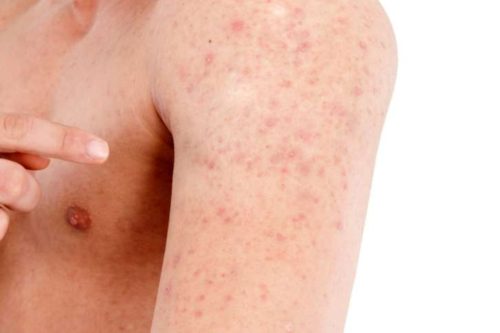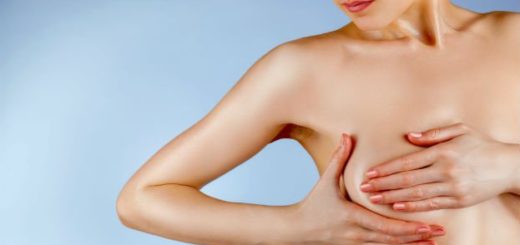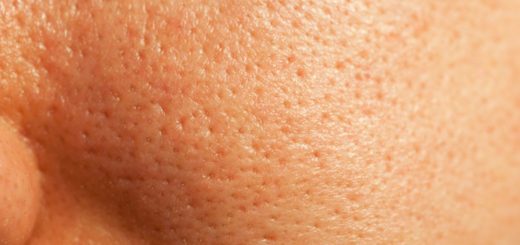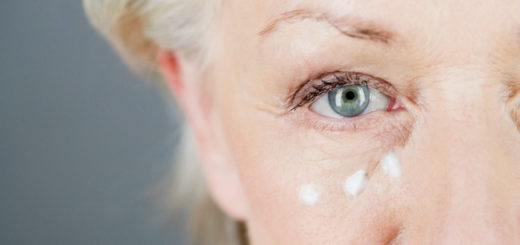10 Ways To Get Rid Of Keratosis Pilaris Fast
The patches of little red or white bumps on your cheeks, upper arms, thighs or backside are called keratosis pilaris. It does not cause any pain or discomfort unless it gets inflamed. The bumps are hair follicles that get clogged by dead skin cells. Dry skin conditions, allergies and hormonal changes seem to be the contributing factors.
This disorder affects nearly half of the adults and even adolescents. Although this is not a serious or harmful medical condition, you want to get rid of keratosis pilaris for good.
1. Exfoliation
Regular exfoliation is a simple way to reduce the bumps. It helps remove the dead cells on the skin surface, and the extra pile over the follicles, opens them up and releases the trapped hair, if any. There is considerable visible improvement within a few weeks, but you should exfoliate the skin regularly to maintain a smooth skin.
Exfoliation can be done:
- Mechanically: Although mechanical peeling does not involve any active chemicals, it may irritate sensitive skin. The constant rubbing can dehydrate the skin and make it rougher over time.
- Using chemical or herbal peeling.
2. Loofah Or Sponge Scrub
Use a natural sponge, loofah gourd or a washcloth to rub the skin while bathing. Do not be very harsh; as you cannot rub off the bumps at one go. Harsh scrubbing may irritate the skin and inflame the follicles.
3. Alpha Hydroxy Acid
This is a mild natural acid. Using a cream with alpha hydroxy acid helps in moisturizing the skin from deep within and reducing the impact of the condition. This cream will also help in exfoliation of the skin and leave it soft.

4. Coconut Oil
Coconut oil is ideal for sensitive skin as it has anti-inflammatory properties. This natural oil is packed with nutrients that are good for your health, whether taken internally or applied externally. A very effective natural cure for keratosis pilaris is coconut oil. Use extra virgin coconut oil regularly on the affected areas and also all over your skin. The fatty acids get absorbed easily and helps moisturize the skin. The anti-inflammatory and anti-bacterial properties of this oil help any infections.
Coconut Oil Skin Rub
Make a semisolid paste with:
- Coconut oil 2 tbsp
- Granulated or brown sugar 2 tbsp.
Apply this paste on the affected area of the skin and rub on with a circular motion. The semisolid paste will melt into a liquid with the heat from the skin. Wipe off and then rinse with water. The oil gets completely absorbed into the skin, so plain water is enough to remove the sugar crystals.
Many people have recovered from keratosis pilaris with regular application of coconut oil.
5. Oatmeal Bath
Oatmeal bath helps moisturize your skin and prevent keratosis pilaris. Soak in an oatmeal bath at least thrice a week. Add a handful of powdered oats to lukewarm water and soak in it for 15 minutes. Shower and then dry yourself with a towel very gently.
Oatmeal Skin Rub
Oatmeal is a gentle and skin-friendly scrub that will smoothen out the bumps. Take:
- Crushed oatmeal 2 tbsp
- Water/milk 2-3 tbsp.
Mix them and apply on the affected area. Rub it on with a circular motion for a few minutes and then wash off. This seems to be a messy affair, but this will surely make your skin silky. If you want to avoid the mess, bundle up the oatmeal in a thin muslin cloth and use it to rub down the skin while bathing.
6. Olive Oil
Olive oil is a rich source of vitamin E, which is very beneficial for treating several skin conditions. It is also a very good natural cure for keratosis pilaris as it helps reduce rough and dry skin.
Olive Oil Skin Rub
Make a slightly abrasive skin rub by mixing:
- Olive oil 2 tbsp
- Table salt 3 tbsp.
Or
- Olive oil 2 tbsp
- Sugar 3 tbsp
- Little warm water.
Rub any one of these mixtures on the skin and massage for a few minutes, and then wash off with a mild soap. While the salt and sugar in these rubs exfoliate, the olive oil moisturizes the skin. So, this is a two-in-one method to treat keratosis pilaris.
7. Milk
The lactic acid in milk helps to moisturize and exfoliate the skin, thus reducing the bumps. Apply milk, buttermilk or yoghurt on the skin every day and leave it on for some time. This helps to exfoliate the skin and keep it well moisturized and soft.
Yoghurt
Applying yoghurt helps reduce skin dryness and it also gets rid of the excess keratin that gets deposited on the skin due to keratosis pilaris. Apply yoghurt on the affected areas 15 minutes before your bath. Shower with cold or lukewarm water and gently wipe your skin dry with a soft towel.
8. Baking Soda
Baking soda is an outstanding exfoliant that removes dead skin cells and deep cleans the skin pores.
Mix together:
- Baking soda 2 tbsp
- Table salt 2 tbsp.
Add enough water to this mixture to make a paste. Apply on affected area and leave for 5-10 minutes. Rub well and wash off. Repeat it 3-4 times a week. Baking soda has a mild chemical action on the keratosis pilaris and the salt provides the abrasive power.
9. Apple Cider Vinegar
Apple cider vinegar is a very beneficial natural cure for keratosis pilaris. Using a cotton ball apply it daily on the affected areas. Apple cider vinegar helps cleanse the skin and get rid of the excess keratin deposits. Its anti-inflammatory properties help to prevent any infection in the affected area and provide quicker healing.
10. Diet Modifications
Since dry skin can worsen keratosis pilaris, keep your skin hydrated from the inside.
- Drink plenty of water. Have at least 8-10 glasses of water every day to keep your skin well hydrated.
- Eat lots of fresh fruits and veggies.
- Eat vitamin A rich foods as a deficiency of this vitamin causes dry and scaly skin. Vitamin A helps rebuild skin tissues and heal damaged skin. Some best food sources of this vitamin are carrots, pumpkin, leafy greens, eggs, liver, etc.
- Take foods rich in omega 3 fatty acids like oily fish, nuts, or fish oil supplements.
- Many herbs help improve the body’s immune system and treat skin conditions by softening the skin. Herbs like calendula, chickweed, marshmallow, burdock, slippery elm, etc., are very beneficial for people suffering from keratosis pilaris. They provide relief from the symptoms and provide faster healing if taken regularly.
Do’s and Don’ts
As keratosis pilaris is an inflammatory disorder, reducing inflammation will help a great deal. You should:
- Avoid bar cleansers and bar soaps, because the ingredients that keep them in the bar form can clog pores and make it worse.
- Avoid scrubbing the skin severely as these bumps cannot be scrubbed away. This problem is not at the surface of your skin and scrubbing will only further irritate and inflame the skin.
- Use gentle cleansers and moisturizers to keep your skin smooth.
- Apply a moisturizer after bath to keep the skin hydrated.
- Eat a well-balanced diet and avoid eating more junk foods. Include flaxseeds, healthy oils, and lots of citrus fruits in your daily diet.
- Avoid preserved and processed foods as they can cause flare-ups.
- Avoid caffeinated drinks and beverages.
- Avoid alcohol as it can dry your skin.
- Improve your digestion as a weak digestive system leads to poor immunity, several skin conditions and allergies.
- Get some sunlight as vitamin D deficiency can also cause dry skin and result in skin conditions like keratosis pilaris. Apply sunscreen lotion before you step out in the sun. Spending half an hour under the sun daily helps get your required dose of vitamin D.
- Refrain from taking very hot showers or baths as they can make your skin dry.


